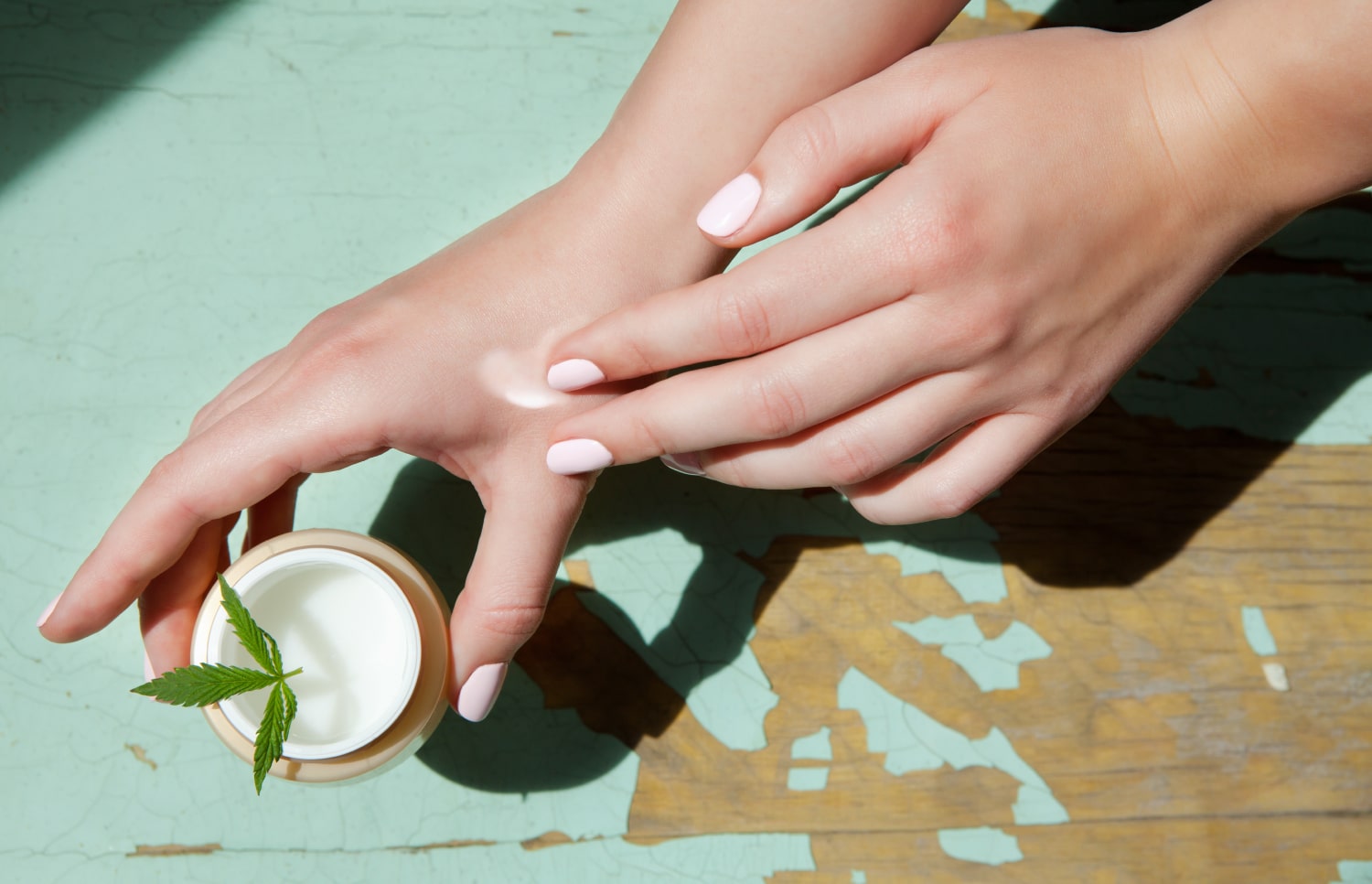Can CBD Be Absorbed Through the Skin?
|
| Imagine soothing your tense muscles or easing discomfort with a simple swipe of a lotion. This might sound like a futuristic dream, but it's already a reality for many who have discovered the power of CBD-infused topicals. |
Cannabidiol, more commonly known as CBD, has taken the wellness world by storm, and it's not hard to see why. With its myriad potential benefits, this remarkable compound has the potential to revolutionize the way we approach skincare and discomfort relief.
But how exactly does CBD work its magic when applied to the skin? Can it truly be absorbed and deliver the benefits it promises? Let's delve into the fascinating world of CBD and skin absorption, exploring everything from the science behind the process to the best delivery methods for optimal results.
What Is CBD?
Before diving into the intricacies of CBD and skin absorption, it's crucial to lay the groundwork by understanding what CBD actually is. Extracted from the Cannabis sativa plant, CBD is one of over 100 naturally occurring compounds known as cannabinoids.
Unlike its psychoactive counterpart, THC (tetrahydrocannabinol), CBD does not produce the "high" commonly associated with cannabis. Instead, CBD has gained popularity for its potential therapeutic properties, making it an attractive option for those seeking a non-intoxicating way to harness the plant's benefits.
How Does the Skin Work?

Often overlooked, the skin is our body's largest and most versatile organ, serving as a protective barrier against environmental aggressors and regulating temperature, among other vital functions. To better understand how CBD interacts with the skin, it's essential to examine its three primary layers.
These include the:
-
Epidermis: The outermost layer of the skin, theepidermis, is composed of multiple sub-layers and is responsible for producing keratinocytes, which form a protective barrier. It also houses melanocytes, the cells responsible for pigmentation.
-
Dermis: Beneath the epidermis lies the dermis, a thicker layer containing blood vessels, hair follicles, sweat glands, and nerve endings. This layer is primarily comprised of collagen and elastin, which are proteins that provide the skin's structural support and elasticity.
-
Subcutaneous layer: The deepest layer of skin, the subcutaneous layer, consists of fat and connective tissue that cushion and insulate the body. It also serves as an energy reserve and aids in absorbing certain substances, including CBD.
What Is the Endocannabinoid System?
A pivotal component in understanding CBD's interaction with the skin is the endocannabinoid system (ECS). Found throughout the body, the ECS is a complex cell-signaling system that plays a crucial role in maintaining homeostasis, or balance, in various physiological processes.
Comprised of three main components — endocannabinoids, receptors, and enzymes — the ECS influences many functions, including skin health.
CBD's potential benefits largely stem from its relationship with the ECS. By interacting with various receptors and enzymes, CBD may help ease bodily tension, soothe discomfort, and support overall skin health.
With this foundational knowledge, we can delve into how CBD is absorbed through the skin and harnessed for its therapeutic potential.
What CBD Products Can Be Applied Topically?
As the popularity of CBD has soared, so has the variety of products available. Consumers have many options for topical applications, ranging from creams and lotions to salves, ointments, balms, and patches.
Each form has its unique characteristics, catering to diverse preferences and needs:
-
Creams: These water-based formulations blend CBD with moisturizing ingredients for a luxurious and hydrating experience.
-
Lotions: Similar to creams but with a lighter consistency, lotions offer quick absorption and a non-greasy finish.
-
Salves: Infused with CBD, these semi-solid ointments often incorporate oils and waxes to create a thicker, more protective barrier on the skin.
-
Ointments: Like salves, ointments provide a heavier consistency for long-lasting protection and targeted relief.
-
Balms: Solid at room temperature, balms melt upon contact with the skin, delivering a concentrated dose of CBD.
-
Patches: Designed for slow, sustained release, transdermal patches adhere to the skin, gradually delivering CBD over an extended period.
How Does Topical Application Work?
Topical CBD products work by interacting with cannabinoid receptors found within the skin's surface. The CBD penetrates the outermost layer upon application, potentially influencing physiological processes like the regulation of discomfort.
The efficacy of topical CBD largely depends on its ability to permeate the skin and reach the desired receptors.
Several factors influence this process:
-
Permeation: Refers to a substance's movement through the skin's layers. Factors such as CBD's molecular size and lipophilicity play a role in its permeation efficiency.
-
Penetration: The ability of CBD to enter the skin and reach its target receptors hinges on penetration. Formulation and concentration can impact this process.
-
The stratum corneum: The skin's outermost layer, the stratum corneum, is composed of dead skin cells and lipids, forming a barrier that presents a challenge for CBD penetration. Enhancing permeability through this layer is key to ensuring optimal absorption.
What Are Transdermal CBD Delivery Systems?
While topical CBD products are designed to act on the skin's surface, transdermal applications aim to deliver CBD directly into the bloodstream. This method offers a more systemic effect, allowing CBD to reach receptors throughout the body.
Innovative delivery systems such as liposomes and nanoparticles have emerged to overcome skin permeation and penetration challenges. These microscopic carriers encapsulate CBD, enhancing its solubility and ability to cross the skin's barrier.
In addition to liposomes and nanoparticles, transdermal CBD products often incorporate carrier oils and terpenes, which may enhance absorption and offer additional benefits. Carrier oils, such as coconut or hemp seed oil, facilitate the delivery of CBD, while terpenes, aromatic compounds found in plants, may enhance CBD's therapeutic potential through the "entourage effect."
What Are the Advantages and Limitations of Transdermal CBD?
Transdermal CBD offers several advantages, including controlled release, better bioavailability, and systemic effects. However, this delivery method may not suit all applications or individuals.
Considerations such as cost, potential skin irritation, and the need for a more targeted approach may lead some consumers to opt for traditional topical CBD products instead. Ultimately, the choice between transdermal and topical CBD will depend on individual needs, preferences, and the desired outcome.
With a solid understanding of the diverse array of CBD products and the science behind their absorption through the skin, consumers can make informed decisions about which options best suit their unique requirements. In addition, by considering factors such as product formulation, delivery method, and personal goals, individuals can harness the full potential of CBD and reap its myriad of potential benefits.
How Can CBD Help the Skin?

As more and more people turn to CBD-infused skincare products, researchers are beginning to investigate the potential therapeutic benefits of this natural compound for skin health.
Here are some of how CBD may support skin health and provide relief:
-
Soothes irritation: CBD has shown the potential to relieve discomfort and irritation by interacting with the body's endocannabinoid system. While we cannot make any medical claims, anecdotal evidence suggests that CBD may offer a welcome respite for those with skin discomfort.
-
Minimizes the appearance of aging: Some studies have suggested that CBD may minimize visible signs of aging. By soothing skin, CBD may help even skin texture and address the appearance of fine lines and wrinkles.
-
Calms breakouts: CBD may also help alleviate symptoms of breakouts by supporting balanced sebum production, which can clog pores if left alone. Additionally, CBD's many properties may help ease redness and swelling associated with breakouts.
While more research is needed to fully understand the potential benefits of CBD for various skin concerns, many people have reported positive results from using CBD-infused skincare products. As with any new skincare regimen, it's important to consult a healthcare professional before trying new products, especially if you have a history of skin allergies or sensitivities.
What Are the Main Safety Considerations for CBD Skincare Products?
As the use of CBD in skincare products becomes increasingly popular, it is essential to prioritize safety and consider several factors before incorporating these products into one's routine. In this section, we'll discuss the primary considerations to remember.
THC Content and Legal Considerations
Understanding the THC content of a CBD product is crucial, as it can have legal implications and impact the user's experience. Ensure the product complies with local regulations and contains a THC concentration within the legally permissible range. It is also essential to know potential drug testing requirements or restrictions in your area.
Hemp vs. Cannabis
The source of CBD in a product can impact its efficacy and safety. Hemp-derived CBD typically contains negligible amounts of THC and is generally considered safer. On the other hand, cannabis-derived CBD may have higher THC concentrations, which can pose legal concerns.
Quality and Purity of Ingredients
When selecting a CBD skincare product, it is essential to verify the quality and purity of its ingredients. Look for products that have undergone third-party testing to ensure they meet safety and quality standards. This step can help you avoid harmful contaminants or unwanted ingredients irritating your skin.
Allergies and Skin Sensitivities
Be mindful of any allergies or skin sensitivities when using CBD skincare products. While CBD is generally well-tolerated, it's always a good idea to perform a patch test on a small skin area before applying it to larger areas. This step can help you avoid any adverse reactions or irritation.
Interactions With Other Medications or Treatments
As with any new addition to your skincare routine or wellness regimen, be aware of potential interactions between CBD and other medications or treatments. Consult a healthcare professional to determine whether CBD suits your specific circumstances. They can also help you understand any potential drug interactions or safety concerns.
The Bottom Line
CBD holds significant potential for a wide array of skin conditions and concerns. Its skin-supporting properties and ability to address discomfort make it an intriguing option for many seeking relief. As with any skincare product, prioritizing safety and considering various factors is crucial when selecting CBD-infused options.
Unlock the potential of CBD for your skin health with Muscle MX, a trusted partner in the pursuit of improved well-being. Muscle MX offers a range of CBD-infused skincare products designed to help you optimize the health and appearance of your skin. So whether you're looking to support your overall skin health or soothe irritation, Muscle MX's skincare solutions are formulated with quality ingredients to deliver dependable results.
Sources:
The endocannabinoid system: Essential and mysterious | Harvard Health Publishing
Epidermis (Outer Layer of Skin): Layers, Function & Structure | Cleveland Clinic
Therapeutic Potential of Cannabidiol (CBD) for Skin Health | PMC












































